Wireless sensors in construction
by nithya_caleb | September 15, 2018 12:00 am
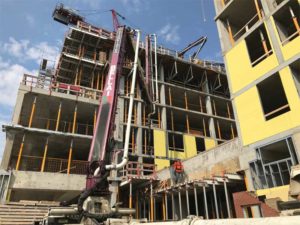 [1]
[1]By Roxanne Pepin
Just like new standards and regulations, the adoption of new technologies in the construction industry is a slow process. In fact, one of the main reasons why it can be such a challenge to adopt new standards and regulations is the industry’s failure to keep up with technology. Decision-makers in construction are hesitant to let go of traditional design, building, and testing methods. In a world where everything is becoming more connected and new systems are being developed for every facet of life, the use of smart technologies in construction is essential. More specifically, the use of sensors and devices for monitoring and assessing structural and material properties of concrete is essential.
Sensor technology
Granted they are not currently adopted everywhere, smart sensors in construction are becoming more popular as engineers and contractors realize their many advantages. Sensors and devices are being developed for a number of different applications on the jobsite. Some are designed strictly to monitor the properties of concrete during curing, while others are designed to track environmental conditions or project equipment.
When it comes to monitoring the properties of concrete, such as temperature, strength, maturity, moisture content, pH, and relative humidity (RH), sensors can help optimize project schedules, and ensure safety and durability. In some cases, construction companies have been able to save up to four months on the entirety of a bridge or high-rise construction project by using real-time wireless concrete temperature sensors. These sensors are used for monitoring properties starting with the early construction stage during mixing, placement, and curing of concrete. They aid in making the process more efficient by optimizing critical operations. These include ensuring proper moisture content during mixing, and removing formwork and post-tensioning during the building process. The performance and condition of concrete during construction is a major concern for the safety and life of the structure.
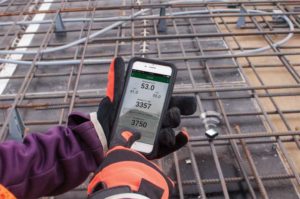 [2]
[2]With these wireless sensors, general contractors (GCs) and engineers are able to gather critical data with ease. Traditionally, these sensors are connected via an intricate system of wires and data loggers. In recent years, advancements have facilitated the development of wireless sensors, thereby eliminating the need for data loggers and exposed wires by utilizing smartphone technology. Without the need for wired sensors, many of the challenges associated with them—reading errors caused by wire crossover, accidental damage or cutting of wires, and mislabeled wires—are eliminated. Contractors or workers on the jobsite can connect to these new sensors, download data instantly, and share it wirelessly with the project engineers or office using their smartphone or tablet. Access to real-time concrete temperature and maturity information has helped contractors reduce project schedules by days, weeks, and even months, therefore saving thousands of dollars in operational and laboratory testing costs. Being able to ensure a structure has reached the required strength before moving on to the next phase of the building process helps reduce the margin for error and eliminates safety risks due to stress fractures and slow strength gain.
Other types of sensors have been developed to increase workers’ safety on the jobsite by monitoring potentially dangerous conditions such as heat, noise levels, dust, and the presence of hazardous fumes. These systems are equipped to send real-time notifications and alerts to workers, safety managers, and superintendents. They are intended to minimize the risk for potential accidents, and reduce the margin for error. The use of these systems results in an increase in productivity by helping construction managers avoid costly delays and increase safety and satisfaction of the workers by eliminating danger and providing a more favourable work environment. They can also eliminate the hassle of hiring outside consulting services to monitor onsite conditions, which can be time consuming and costly.
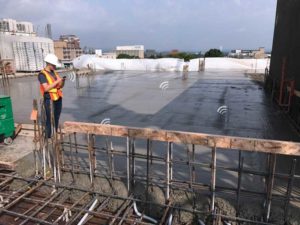 [3]
[3]Smart cities and the Internet of Things
The development of smart cities and growth of the Internet of Things (IoT) encourages the use of advanced technologies in design and construction processes as well as in the wireless sensor networks (WSN) embedded within smart cities. The IoT is a system of connected computers, sensors, devices, or objects with the ability to transfer data over a network without human interference. The introduction of IoT and safety systems is one of the first steps to building smart infrastructure and cities. The IoT is becoming even more important as construction professionals continue to improve day-to-day processes. IoT technologies embedded directly within the concrete will enable smart cities to provide safe, efficient, and interactive infrastructure. The networks within smart cities, which include Seoul in South Korea, Vienna in Austria, and Boston, are developed to maximize the economy, environment, society, and welfare, as well as increase sustainable behaviour among users, companies, and administration.
Benefits of sensor technology
As mentioned earlier, concrete sensors used during the early placement and curing stages of concrete can greatly optimize the building process. They allow stakeholders to monitor project progress and quality every step of the way, and to make any adjustments necessary, ensuring the project is completed with the highest possible level of quality. In one case, wireless concrete sensors helped save time and resources during the construction of a five-floor residential building in downtown Ottawa.
For ready mix producers, smart concrete sensors not only allow them to differentiate themselves within the market through technological innovation, but also through the quality of their product, and the level of service they offer. By adopting leading technology, producers are able to bring more value to the table than their competitors, and generate new, high-margin revenue. They are able to precalibrate their mixes and provide information to customers using smartphone applications. Additionally, they are able to access field data allowing them to see exactly how the mixes perform in different conditions and optimize their performance and durability for future projects. The use of smart concrete sensors by ready mix producers allows the contractors they work with to learn how a mix performs, which in turn, enables them to make better and quicker decisions.
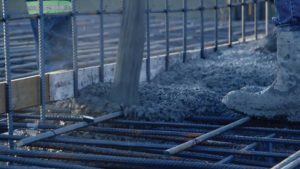 [4]
[4]For contractors adopting smart sensors in their everyday procedures, the return on investment (ROI) is immediate. Contractors and engineers know the value of time when it comes to projects that can take weeks, months, or years
to complete. For example, having access to real-time temperature and strength data means contractors know the perfect time to remove formwork. Waiting too long to remove formwork can result in the concrete sticking to the forms, making them difficult, sometimes impossible, to remove without causing significant damage. If formwork is removed before the concrete has reached optimal strength, the concrete cracks and collapses.
When it comes to project owners, the most evident benefit to using concrete temperature and maturity sensors is the ability to make sound decisions based on accurate data. With the use of RH sensors, project owners can avoid problems related to inadequate testing and premature placement of flooring materials. Premature flooring installation can result in delamination; re-emulsification of the flooring adhesive; and curling, cracking, or blistering of the epoxy coating. Depending on the severity and surface area of these flooring failures, owners can pay upwards of thousands of dollars in repairs for a few square feet of damage.
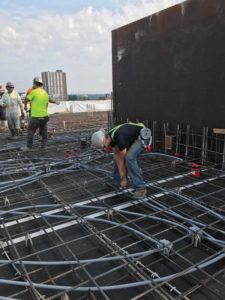 [5]
[5]A new generation of sensors
Canada and the majority of North America is approaching a time where much of its concrete infrastructure will reach the end of its life cycle and will need to be reconstructed. New, non-destructive testing technologies have been developed to assess the state of corrosion in concrete, a necessity to ensure safety of aging infrastructure. As concrete infrastructure is renewed, it is worthwhile to consider the use of technology to not only monitor the condition and properties of concrete during the building process, but further along its life cycle. These new testing methods have also to provide more consistent results and improved ease of use when compared with other non-destructive testing methods.
The labour and work demand associated with the assessment and testing of aging concrete is pushing researchers and engineers toward a new generation of sensors with the ability to monitor the integrity of concrete throughout its lifespan. This becomes especially important as the industry considers the growing number of engineering professionals needed to assess infrastructure as it ages.
Fully embedded concrete sensors are being developed to address issues such as:
- corrosion in steel reinforcement;
- deterioration due to freeze-thaw cycles;
- delamination, softening, and erosion of cement due to sulfate-containing waters entering hardened concrete; and
- cracks caused by alkali-silica reactions within the aggregates.
By including condition-monitoring equipment directly into new concrete infrastructure, it is possible to predict failure without having to rely on the high amounts of labour traditionally necessary for adequate testing. This equipment is also giving engineers a more comprehensive understanding of concrete quality and life-cycle activity.
This technology could also provide building professionals with the ability to monitor and ensure structural integrity of concrete while providing data necessary for optimizing manufacturing and fabrication of failure-proof concrete. Future monitoring systems utilizing smart sensors could provide data on concrete temperature, moisture, and humidity levels, as well as chemicals and pH levels. Not only can these sensors be used to ensure structural durability, but they can also provide a basis for monitoring the integrity of structures designed to withstand natural disasters such as earthquakes. Being able to monitor components or entire structures for deformation, stresses, creep, and strains could result in significant savings in time, cost, and resources.
Conclusion
The adoption of sensors to monitor the properties of concrete during the building cycle provides many advantages to stakeholders, just as the adoption of other sensors and technology used on the jobsite can greatly improve safety and sustainability while reducing project costs and the margin for error. The development and adoption of new concrete sensors for the life-long monitoring of concrete properties is becoming essential as we face the end of the life cycle of much of the country’s infrastructure. Including these new systems in infrastructure renewal projects will, ultimately, improve durability and sustainability of concrete as well as reduce the chances of failure of these new structures as they age.
 [6]Roxanne Pepin is a digital marketing specialist with Giatec Scientific, an Ottawa-based company developing smart technology for the construction industry. She oversees the planning, production, and distribution of communication materials while co-ordinating online marketing efforts relating to digital advertising as well as website and content development. She can be reached at roxanne@giatec.ca[7].
[6]Roxanne Pepin is a digital marketing specialist with Giatec Scientific, an Ottawa-based company developing smart technology for the construction industry. She oversees the planning, production, and distribution of communication materials while co-ordinating online marketing efforts relating to digital advertising as well as website and content development. She can be reached at roxanne@giatec.ca[7].
- [Image]: https://www.constructioncanada.net/wp-content/uploads/2018/09/Image4.jpg
- [Image]: https://www.constructioncanada.net/wp-content/uploads/2018/09/Image1.jpg
- [Image]: https://www.constructioncanada.net/wp-content/uploads/2018/09/Image3.jpg
- [Image]: https://www.constructioncanada.net/wp-content/uploads/2018/09/Image5.jpg
- [Image]: https://www.constructioncanada.net/wp-content/uploads/2018/09/Image2.jpg
- [Image]: https://www.constructioncanada.net/wp-content/uploads/2018/09/DSC_0470.jpg
- roxanne@giatec.ca: mailto:roxanne@giatec.ca
Source URL: https://www.constructioncanada.net/wireless-sensors-in-construction/